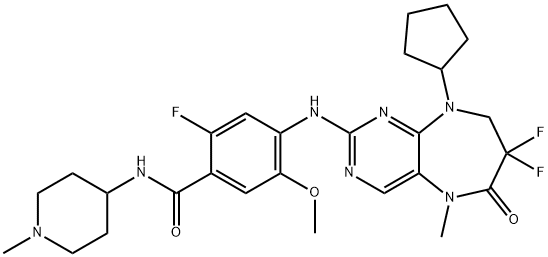TAK-960

|
- ₹0
- Product name: TAK-960
- CAS: 1137868-52-0
- MF: C27H34F3N7O3
- MW: 561.6
- EINECS:
- MDL Number:MFCD22420821
- Synonyms:TAK-960;4-((9-Cyclopentyl-7,7-difluoro-5-methyl-6-oxo-6,7,8,9-tetrahydro-5H-pyrimido[4,5-b][1,4]diazepin-2-yl)amino)-2-fluoro-5-methoxy-N-(1-methylpiperidin-4-yl)benzamide;4-[(9-Cyclopentyl-7,7-difluoro-6,7,8,9-tetrahydro-5-methyl-6-oxo-5H-pyrimido[4,5-b][1,4]diazepin-2-yl)amino]-2-fluoro-5-methoxy-N-(1-methyl-4-piperidinyl)benzamide;CS-1725;TAK 960;TAK960;CS-554;Benzamide, 4-[(9-cyclopentyl-7,7-difluoro-6,7,8,9-tetrahydro-5-methyl-6-oxo-5H-pyrimido[4,5-b][1,4]diazepin-2-yl)amino]-2-fluoro-5-methoxy-N-(1-methyl-4-piperidinyl)-;Polo-like Kinase (PLK),cell,cancer,proliferation,Inhibitor,mitosis,TAK960,TAK 960,leukemia,inhibit,phosphorylation,lines,TAK-960
| Manufacturer | Product number | Product description | Packaging | Price | Updated | Buy |
|---|
Properties
Density :1.39±0.1 g/cm3(Predicted)
storage temp. :Store at -20°C
solubility :≥28.05 mg/mL in DMSO; insoluble in H2O; ≥12.3 mg/mL in EtOH
form :solid
pka :13.21±0.20(Predicted)
color :White to light yellow
storage temp. :Store at -20°C
solubility :≥28.05 mg/mL in DMSO; insoluble in H2O; ≥12.3 mg/mL in EtOH
form :solid
pka :13.21±0.20(Predicted)
color :White to light yellow
Safety Information
| Symbol(GHS): |
  
|
|||||||
|---|---|---|---|---|---|---|---|---|
| Signal word: | Danger | |||||||
| Hazard statements: |
|
|||||||
| Precautionary statements: |
|
Description
Polo-like kinases (Plks) are serine/threonine kinases with key roles in cell cycling. TAK-960 is an orally bioavailable, selective inhibitor of Plks with IC50 values of 0.8, 16.9, and 50.2 nM for Plk1, Plk2, and Plk3, respectively. It exhibits greater than 20-fold selectivity for Plk1 over FAK, MLCK, and the tyrosine protein kinase Fes, and has minimal activity against a panel of 282 other kinases. It inhibits the proliferation of various cancer cell lines, including MDR1-expressing tumors, and also prevents tumor growth in several human cancer cell xenograft models, including a disseminated model of AML- and MDR1-expressing hematological tumors.Related product price
- 6-[(7S)-7-Hydroxy-6,7-dihydro-5H-pyrrolo[1,2-c]imidazol-7-yl]-N-methyl-2-naphthalenecarboxamide
₹17050 - Tak 799
₹18770.55-72570.8 - RESATORVID
₹11740-27080






